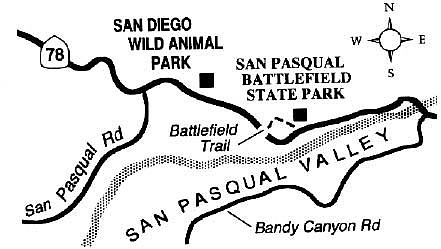 Facebook
Facebook
 X
X
 Instagram
Instagram
 TikTok
TikTok
 Youtube
Youtube
In summer and fall, perhaps two or three centuries ago, Native Americans on the coastal side of the mountains were busy gathering luscious fruit from stands of prickly pear, tuna, and other varieties of cactus. Today, due to decades' worth of intensive cattle-grazing (which has suppressed many nonsucculent plants) and the invasive habit of prickly pear, some of the former gathering grounds are probably richer today than they were in the past.
The short Battle Monument Trail at San Pasqual Battlefield State Historic Park offers a close-up look at dense thickets of prickly pear, ripe red fruits bulging by the hundreds wherever you look. The Indians managed to allay the annoying and painful effects of the tiny spines on the fruits by either burning them off or by deftly slicing both ends of the fruit and peeling back the skin.

You can begin your walk behind the park's attractive visitors' center, on Highway 78, 1.4 miles east of the San Diego Wild Animal Park. In the visitors' center itself you can learn about the 1846 Battle of San Pasqual, as well as the various uses of the region by Native Americans and later settlers.
Walk on the looping nature trail a short way, then continue west on the Battle Monument Trail. After wending through cactus thickets, you soon arrive at a hilltop ramada and bench. From there the broad, flat San Pasqual Valley spreads before you. Most of the valley is still classified as an agricultural preserve within the city limits of San Diego and so has not filled up with subdivisions. In the opposite direction you can spot parts of the artificial savanna at the Wild Animal Park, complete with some of its larger inhabitants. When it's time to go, return the way you came, or else continue west and downhill toward a state historical marker commemorating the battle.

In summer and fall, perhaps two or three centuries ago, Native Americans on the coastal side of the mountains were busy gathering luscious fruit from stands of prickly pear, tuna, and other varieties of cactus. Today, due to decades' worth of intensive cattle-grazing (which has suppressed many nonsucculent plants) and the invasive habit of prickly pear, some of the former gathering grounds are probably richer today than they were in the past.
The short Battle Monument Trail at San Pasqual Battlefield State Historic Park offers a close-up look at dense thickets of prickly pear, ripe red fruits bulging by the hundreds wherever you look. The Indians managed to allay the annoying and painful effects of the tiny spines on the fruits by either burning them off or by deftly slicing both ends of the fruit and peeling back the skin.

You can begin your walk behind the park's attractive visitors' center, on Highway 78, 1.4 miles east of the San Diego Wild Animal Park. In the visitors' center itself you can learn about the 1846 Battle of San Pasqual, as well as the various uses of the region by Native Americans and later settlers.
Walk on the looping nature trail a short way, then continue west on the Battle Monument Trail. After wending through cactus thickets, you soon arrive at a hilltop ramada and bench. From there the broad, flat San Pasqual Valley spreads before you. Most of the valley is still classified as an agricultural preserve within the city limits of San Diego and so has not filled up with subdivisions. In the opposite direction you can spot parts of the artificial savanna at the Wild Animal Park, complete with some of its larger inhabitants. When it's time to go, return the way you came, or else continue west and downhill toward a state historical marker commemorating the battle.
Comments